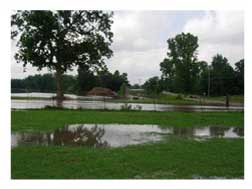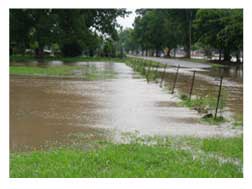Check the lay of the land
 June 15, my trainer & I were standing in the lot by the barn watching the water rise from the creek just south of us. It was slow but relentless. The front lot had small ruts made by my car from the night before as I packed all of my leather goods from the tack room. With each hour, the grass slipped out of sight. The ruts disappeared under a small rush of water that eventually became a small stream in itself. This stream split in two with one half snaking its’ way to the arena and the other half making a straight march for the barn & back pasture. The back pond soon had all of the back pasture consumed except for 2 small rises on which 2 horses were standing. The 5 acre south pasture was becoming a small lake as the creek rose higher. The horses there kept grazing just in front of the moving water line. At 2:00pm, the creek finally crested and the worst of the damage was over. The water had managed to enter the barn and only flooded 2 stalls. We never had to make the decision to move the horses, but there was a plan if needed.
June 15, my trainer & I were standing in the lot by the barn watching the water rise from the creek just south of us. It was slow but relentless. The front lot had small ruts made by my car from the night before as I packed all of my leather goods from the tack room. With each hour, the grass slipped out of sight. The ruts disappeared under a small rush of water that eventually became a small stream in itself. This stream split in two with one half snaking its’ way to the arena and the other half making a straight march for the barn & back pasture. The back pond soon had all of the back pasture consumed except for 2 small rises on which 2 horses were standing. The 5 acre south pasture was becoming a small lake as the creek rose higher. The horses there kept grazing just in front of the moving water line. At 2:00pm, the creek finally crested and the worst of the damage was over. The water had managed to enter the barn and only flooded 2 stalls. We never had to make the decision to move the horses, but there was a plan if needed.
I didn’t check this out when I first came to this barn. I was not a true novice, I had owned horses for several years. But  this is not a question that the ordinary person would normally ask. After all, if you have never experienced a flood, who really thinks of it until the water is rising on your property. The first time it flooded, I was called at work to come help move the horses to the town’s fairgrounds. My husband & I helped move 22 horses & 3 tack rooms in less than 3 hours. We made 3 trips with my 2-horse trailer from the barn to the fairgrounds. Since my late trainer was well known in the area, friends came with other horses trailers, trucks or just time to baby-sit at the fairgrounds while the rest of us made mad dashes back & forth. The horses stayed at the fairgounds for 4 days. We cleaned up the barn, removed all shavings and spread lime on still wet floors. Then it was time to move back.
this is not a question that the ordinary person would normally ask. After all, if you have never experienced a flood, who really thinks of it until the water is rising on your property. The first time it flooded, I was called at work to come help move the horses to the town’s fairgrounds. My husband & I helped move 22 horses & 3 tack rooms in less than 3 hours. We made 3 trips with my 2-horse trailer from the barn to the fairgrounds. Since my late trainer was well known in the area, friends came with other horses trailers, trucks or just time to baby-sit at the fairgrounds while the rest of us made mad dashes back & forth. The horses stayed at the fairgounds for 4 days. We cleaned up the barn, removed all shavings and spread lime on still wet floors. Then it was time to move back.
The most it’s flooded is 5 times in about 2 months. The worst flood was 6 years ago. That time the water also rose slowly, but it just kept rising. The horses were moved, the tack rooms emptied, and everyone prayed. The flood that time was high enough to get 3′ deep in the trainer’s house & barn. It was a true disaster for her. Carpets were removed, sheet rock and insulation were stripped out. It took almost 4 months to get the house renovated. The barn was a little easier. Since it was completely stripped before the water was very high, the stall doors were opened to let the water run freely through the barn. Then it was just a matter of removing any debris left behind and allowing it to dry out.
This should be one of the questions you need to ask the barn manager or proprietor of any boarding facility you are considering. Ask them if the property has ever flooded. If it hasn’t, that is good news. If it has, you need to ask when was the most recent flood. How high has the water been? Most importantly, what is the plan for the horses if it does flood. If there is no plan for floods, make your decision very carefully.
After all, isn’t the safety of your horse the most important service a boarding facility should offer.


